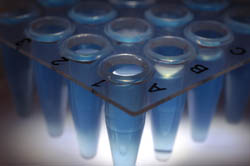DNA arrays for diagnosing neuromuscular disorders
Inherited neuromuscular disorders (NMDs) are a large group of genetic diseases characterised by progressive muscle weakness that leads to wheelchair confinement at a very early age. The increasing identification of new genes in NMD aetiology, combined with the development of novel therapies necessitates diagnostic tools that can perform high-throughput analysis in a very short time period. The currently available molecular diagnostic methods only permit exploration of a single gene at a time and are thus cost intensive and laborious. In Duchenne / Becker muscular dystrophy (DMD/BMD), the dystrophin gene — one of the largest human genes — is affected, and thus mutation analysis of the 78 gene exons is a time-consuming process. Seeking to address this, the EU-funded 'Development of targeted DNA-chips for high throughput diagnosis of neuromuscular disorders' (NMD-CHIP) project aimed to design, develop and validate DNA arrays that could be used to efficiently diagnose patients affected by NMDs. The goal was to enable the assessment of all known disease genes and analyse the data through optimised read-out bioinformatics tools, from within 72 hours to 1 week. For this purpose, partners collected all available sequences of the 45 genes known to cause muscular diseases, and the 43 genes implied in neurological diseases so far, and generated a 2.1 million DNA probe custom DNA array that would allow the detection of gene copy number variations (CNVs)or other gross genetic alterations. The same parts of DNA were also subjected to next-generation sequencing to check for the presence of point mutations. Both types of data was fed into an analysis pipeline to score and evaluate the detected variants with possible functional pathogenic consequences. Apart from the diagnostic arrays, the NMD-CHIP consortium dedicated time to construct research arrays for genes involved in NMD-affected pathways or genes that encoded interacting protein partners. This could provide molecular mechanistic information on NMD pathology and could also unveil new future therapeutic targets. The developed NMD DNA chips have great diagnostic potential and could replace existing laborious methods. Provided the cost is reduced, implementation of these assays into the clinical diagnostic routine would significantly speed up patient diagnosis and treatment.





